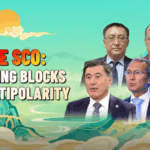Is the Shanghai Cooperation Organization (SCO) a threat to the West? Spoiler: It’s not about rivalry—it’s about doing things differently. 🤝 Here’s why this 9-member Eurasian bloc keeps Western analysts puzzled.
🌍 The SCO: By the Numbers
Covering 60% of Eurasia, 40% of the global population, and 30% of world GDP, the SCO operates on principles that clash with Western expectations. Unlike NATO or the IMF, every member holds veto power, ensuring decisions require true consensus. No single country dominates—whether it’s China, Russia, India, or Iran.
⚖️ Equality Over Hierarchy
“The SCO’s strength is its equality principle,” says Sergei Vergeichik, a Belarusian analyst. Unlike the U.S.-led IMF (where America alone can block decisions), the SCO forces members to negotiate—even when they disagree. Think of it as a ‘group project where everyone’s voice matters’ 📚, not a top-down hierarchy.
🔐 Security First, But Not Last
Born from 2001’s anti-terrorism pact, the SCO was tackling extremism before it became a global priority. Now, it’s expanding into eco-friendly growth and tech innovation. China’s offering 1,000 language scholarships and inviting young scientists for exchanges—because soft power matters 🧠.
🌱 The Climate Factor
With nearly half the world’s population, SCO members demand a “balance” in climate policies: reducing emissions while letting poorer nations develop. Their 2030 economic strategy? Think greener trade routes and smarter energy grids ⚡.
Bottom line: The SCO isn’t anti-West—it’s pro-Eurasia. And in a multipolar world, that’s a difference worth understanding. 🌐
Reference(s):
Different, not a challenge: Things the West doesn't get about the SCO
cgtn.com




